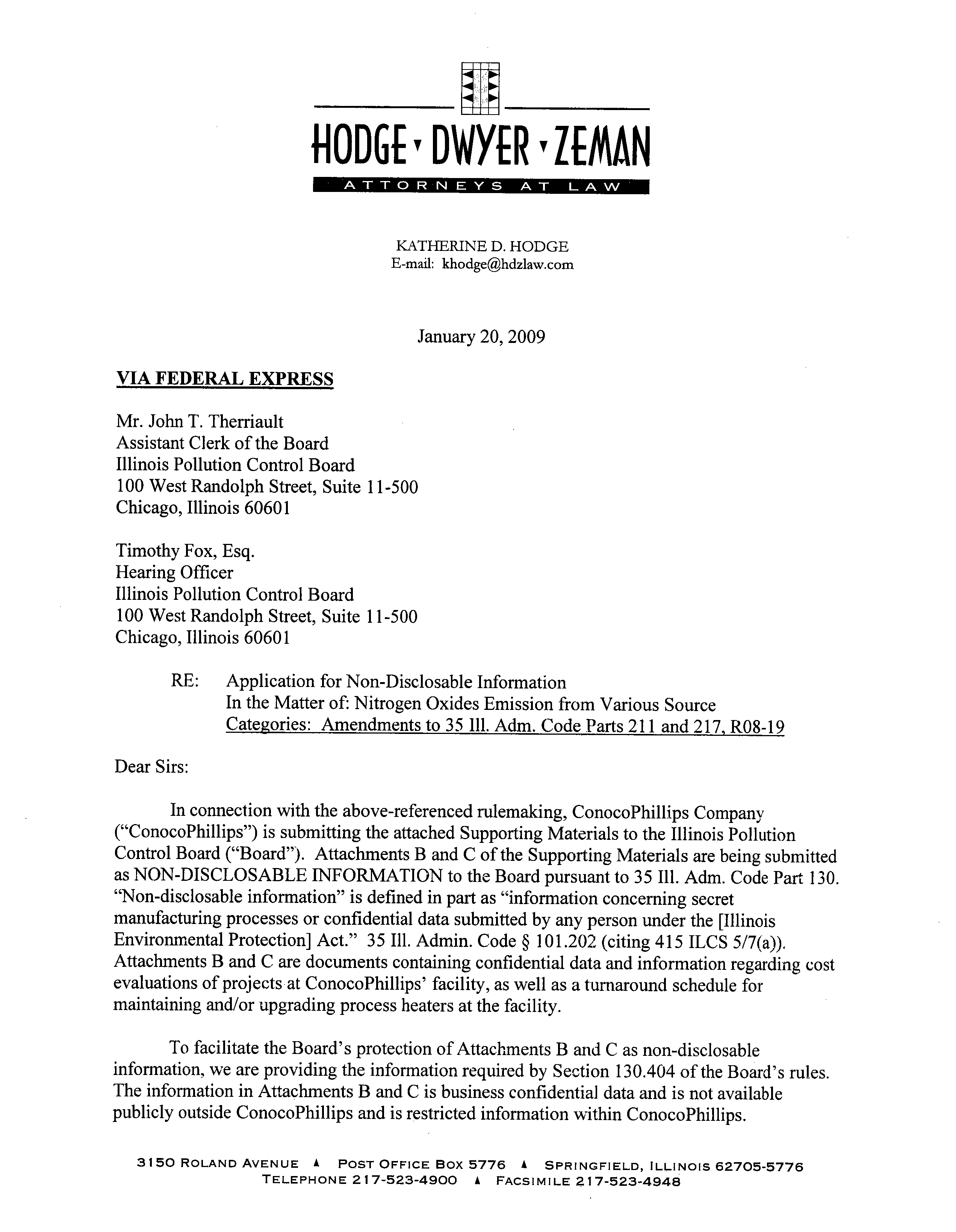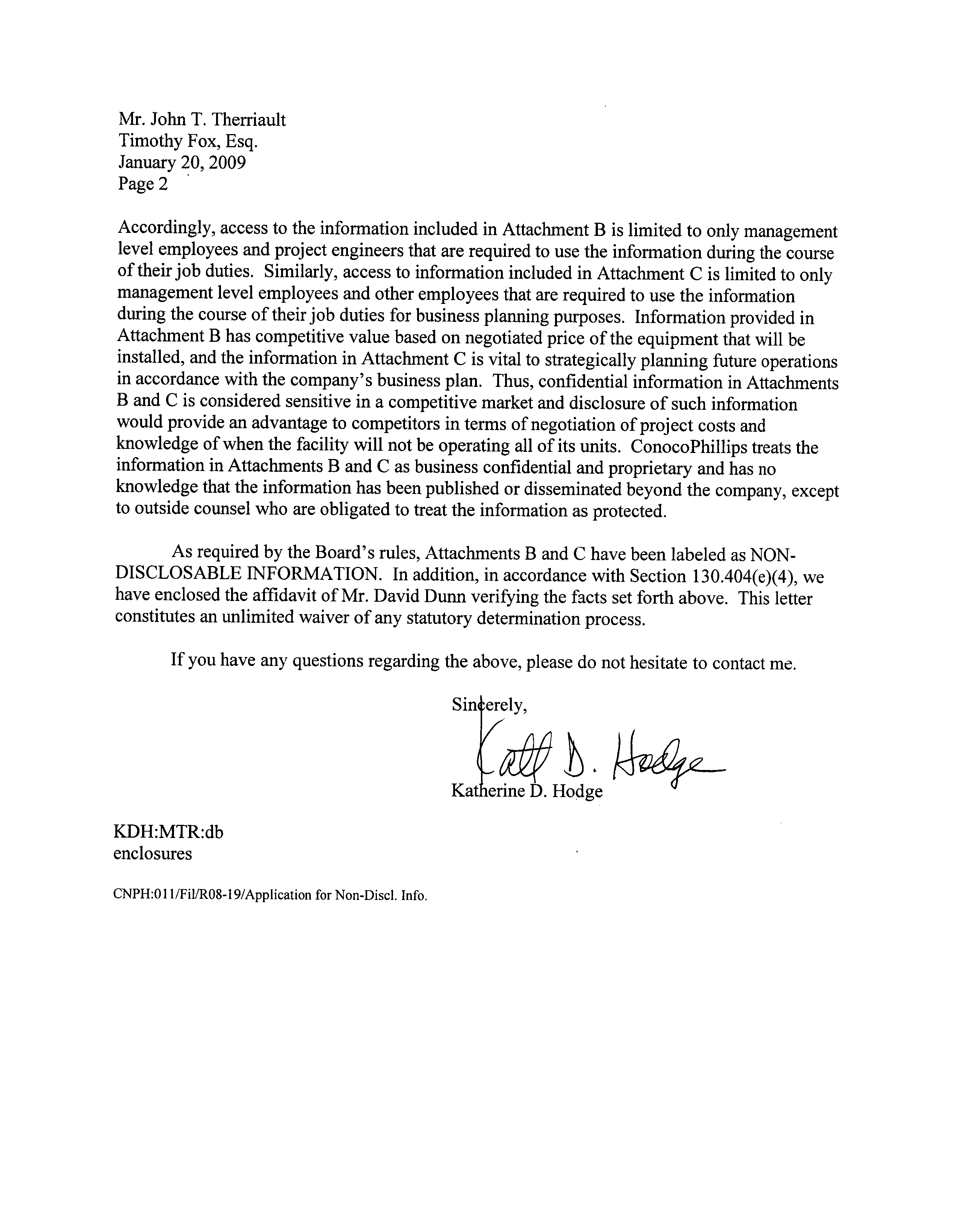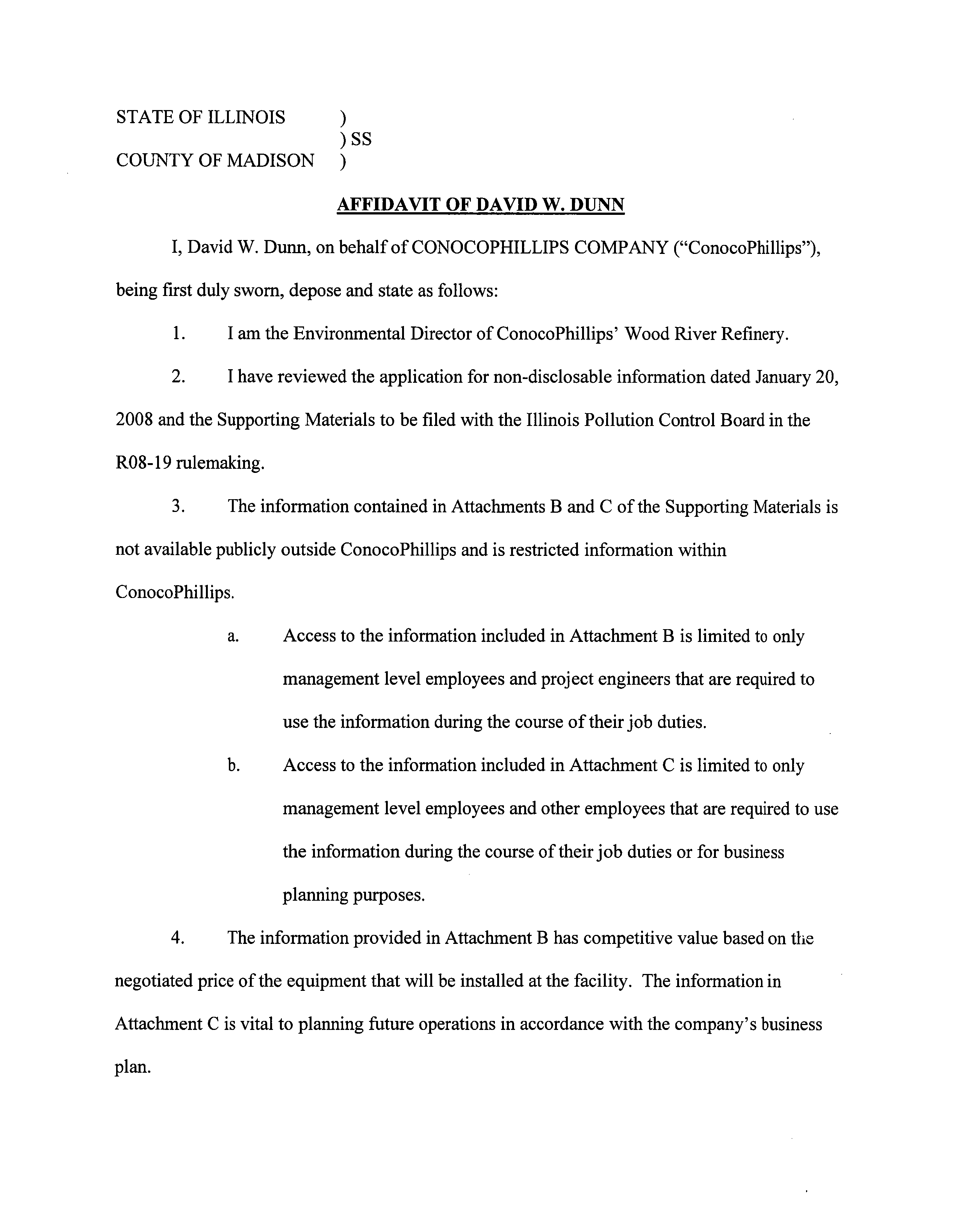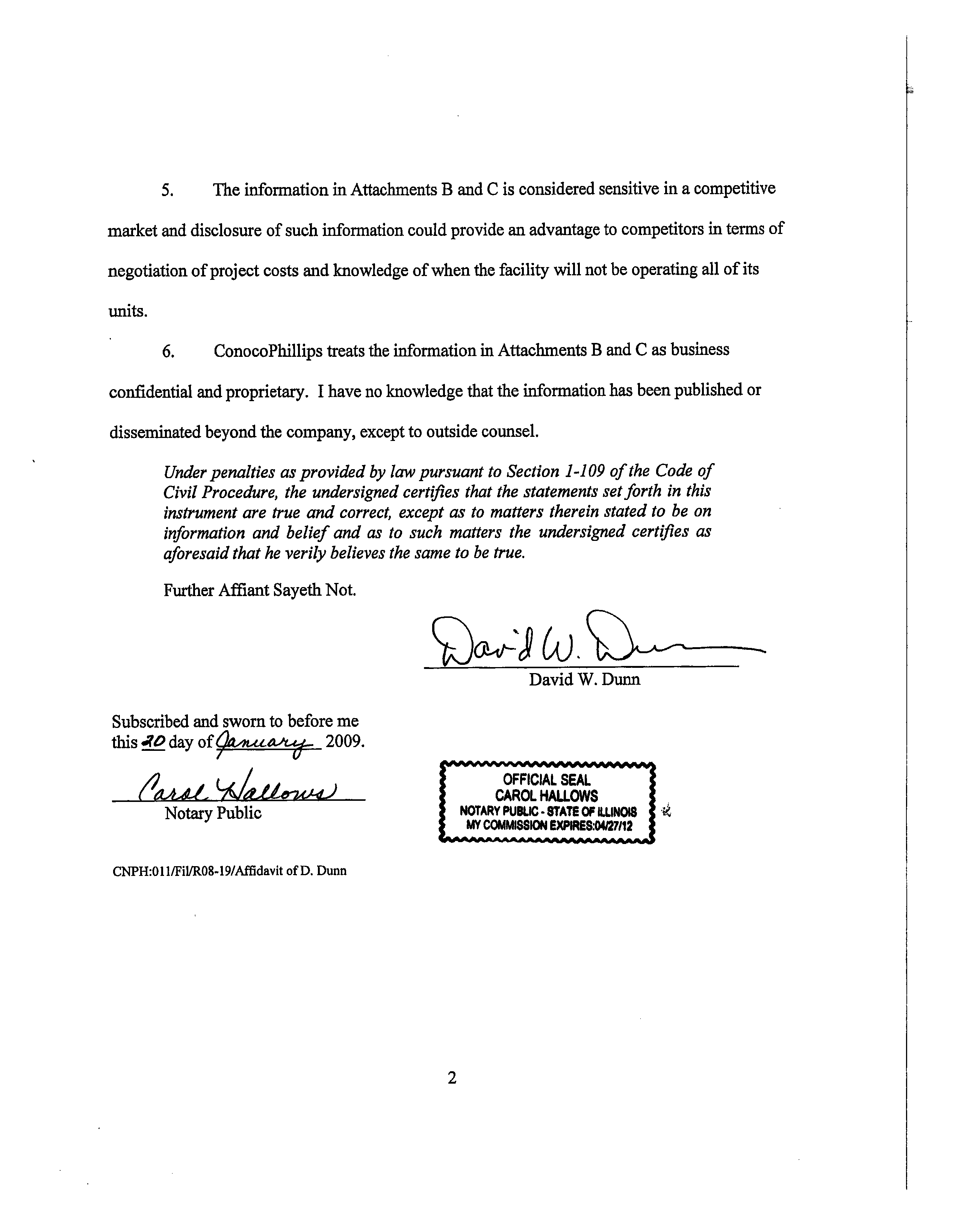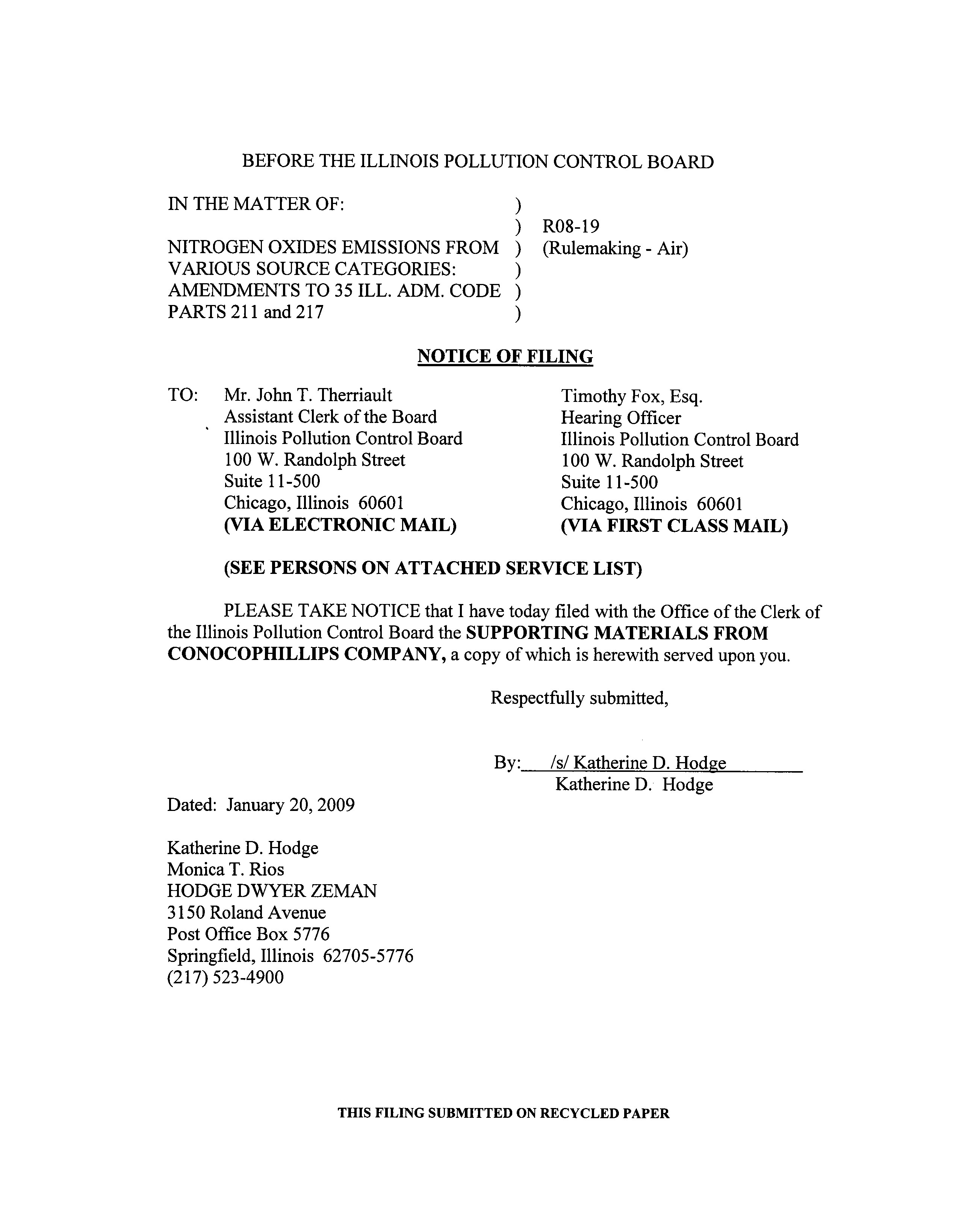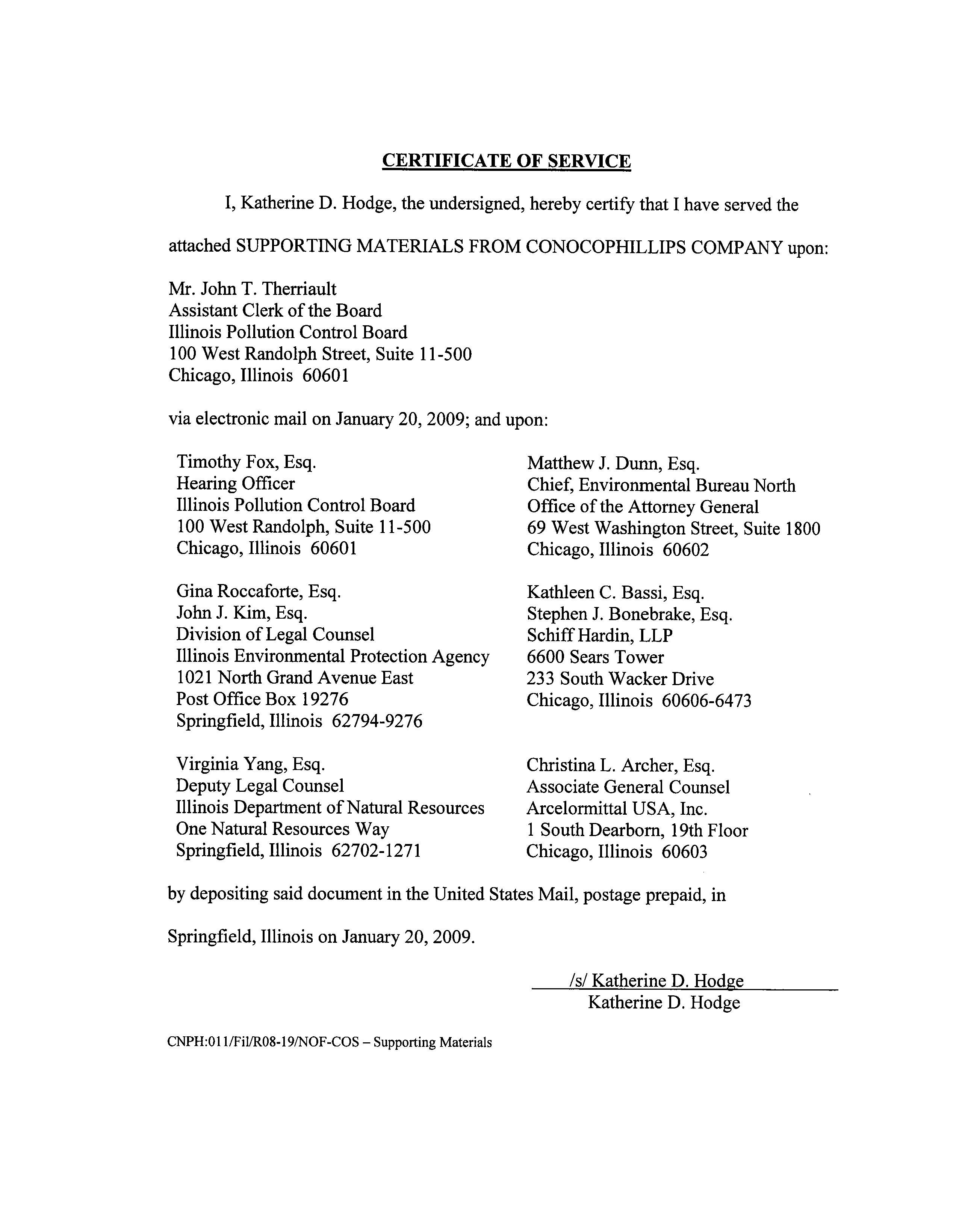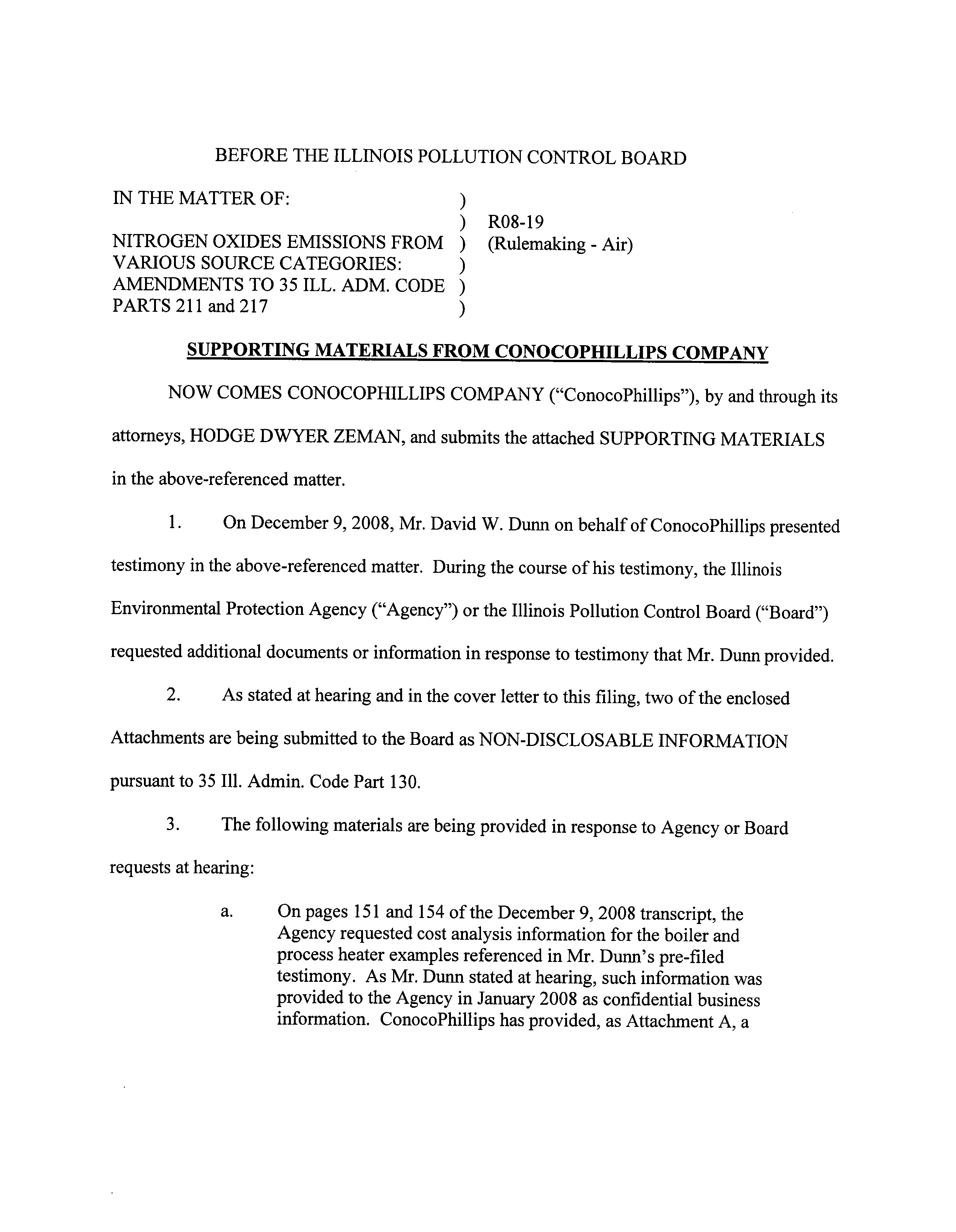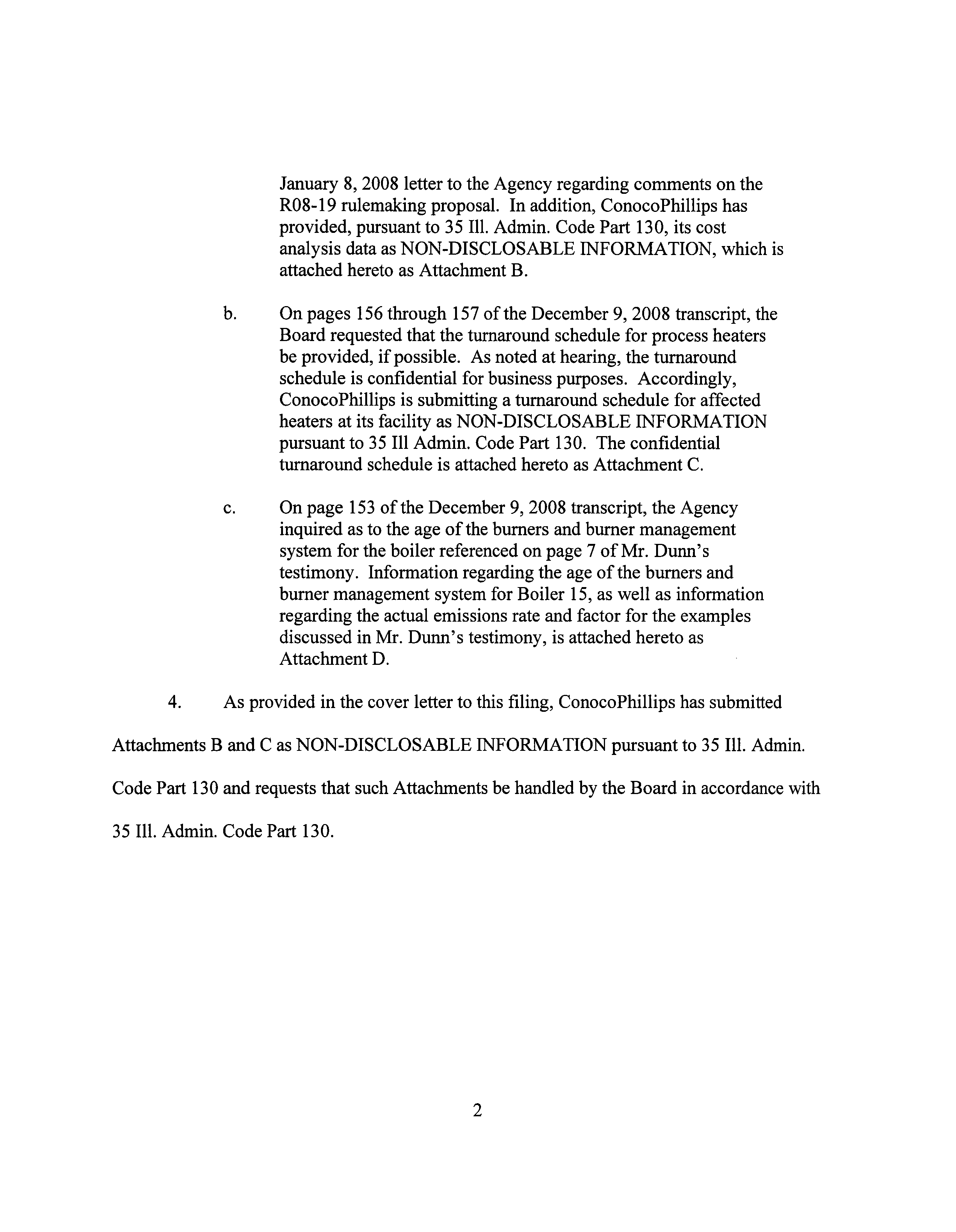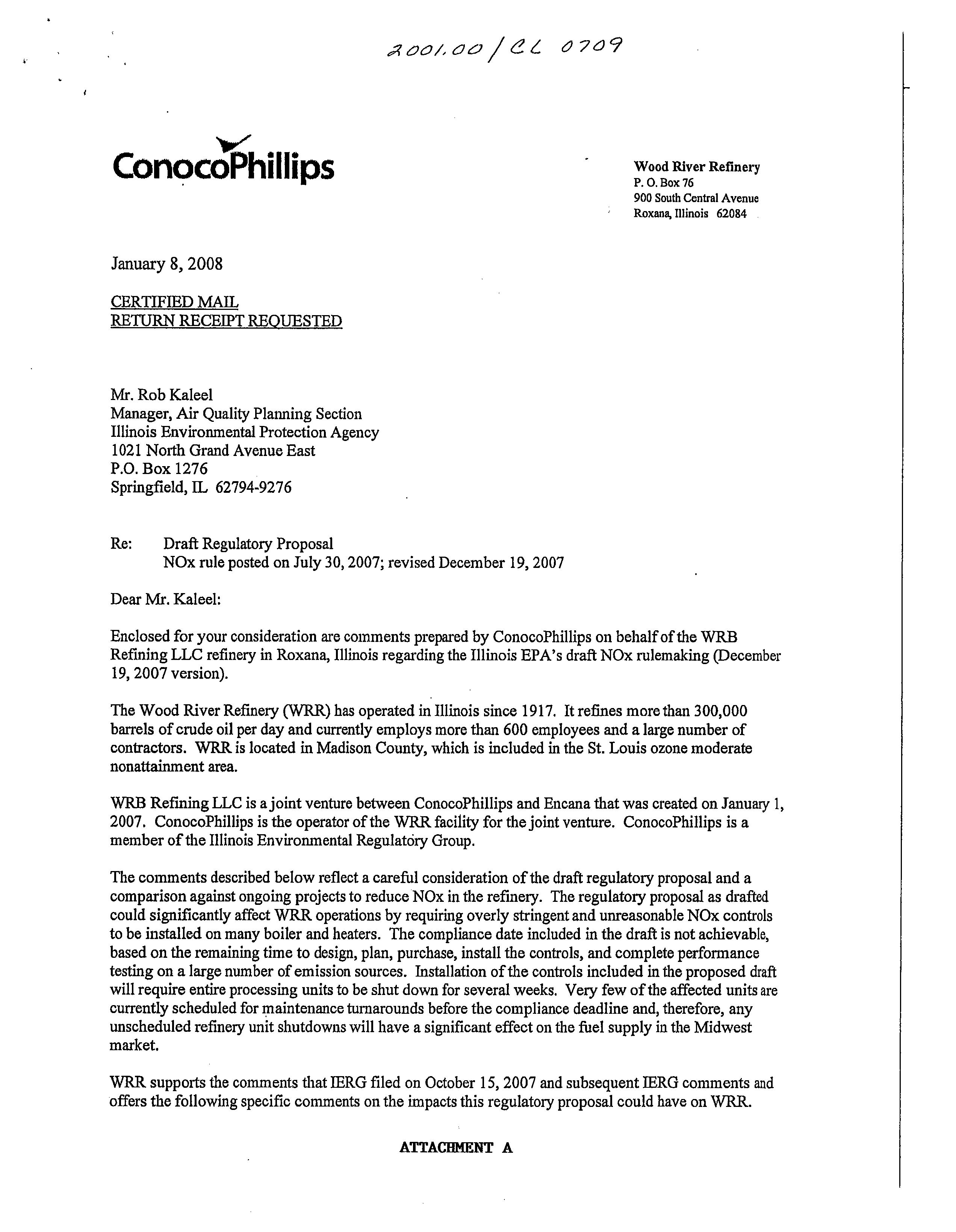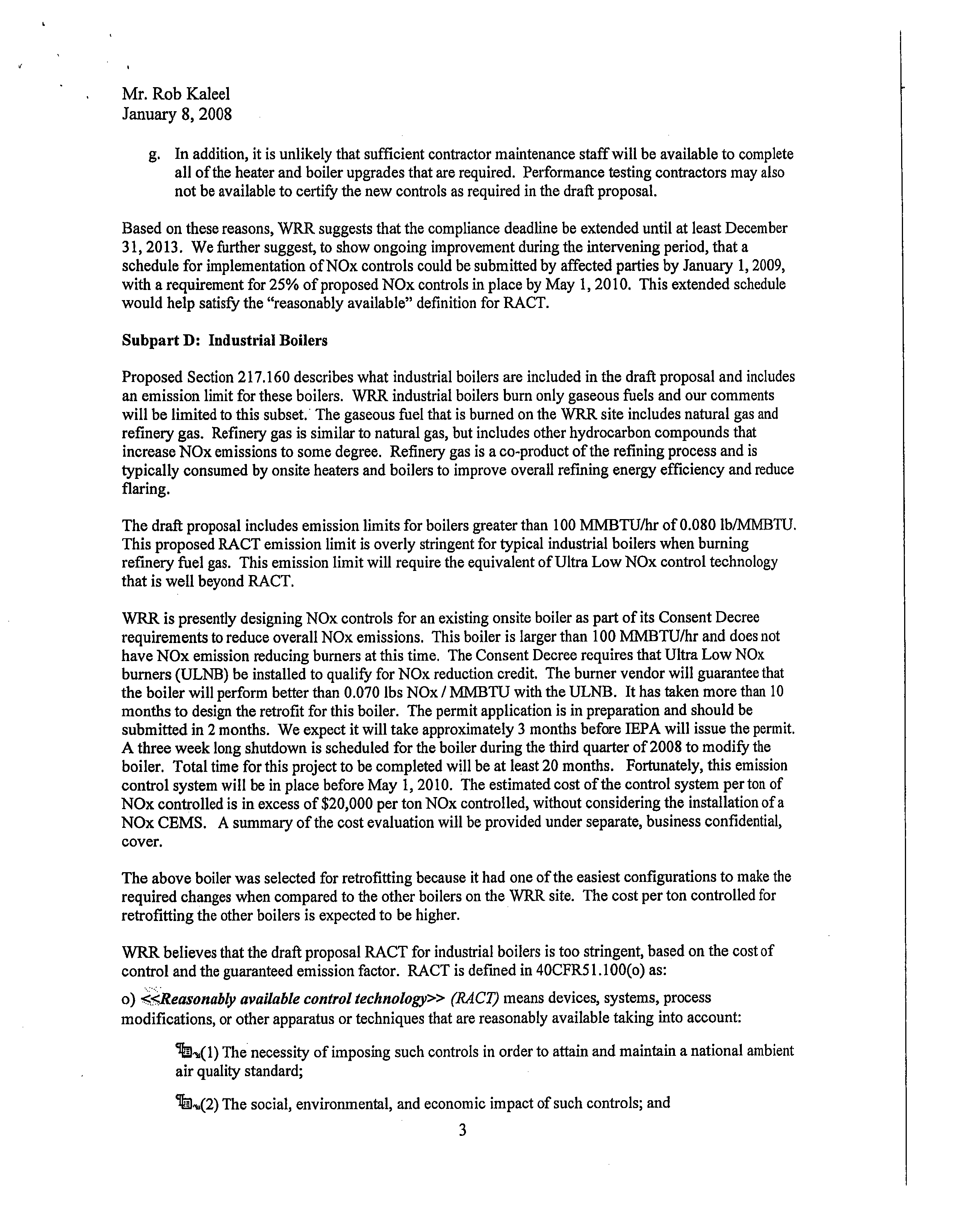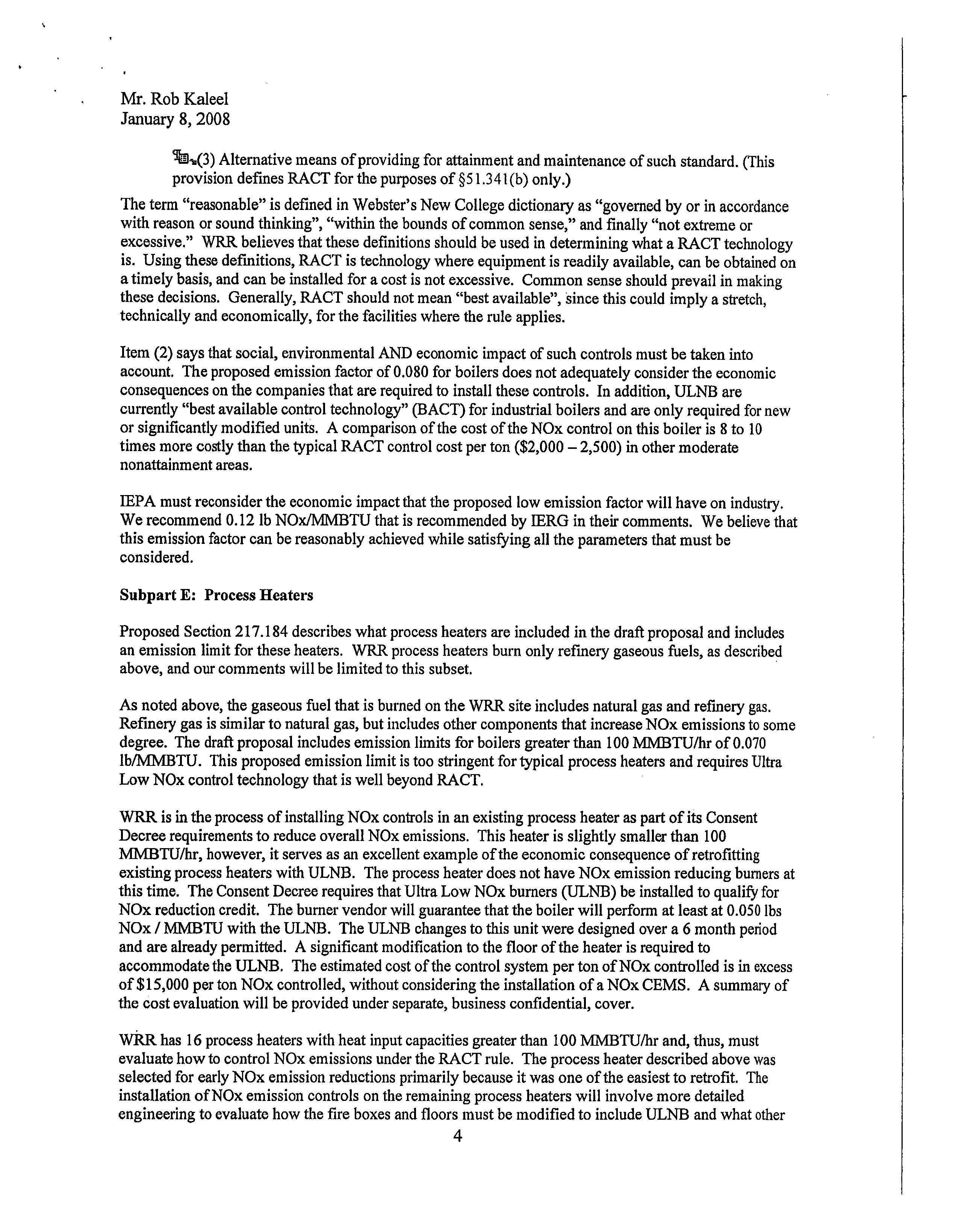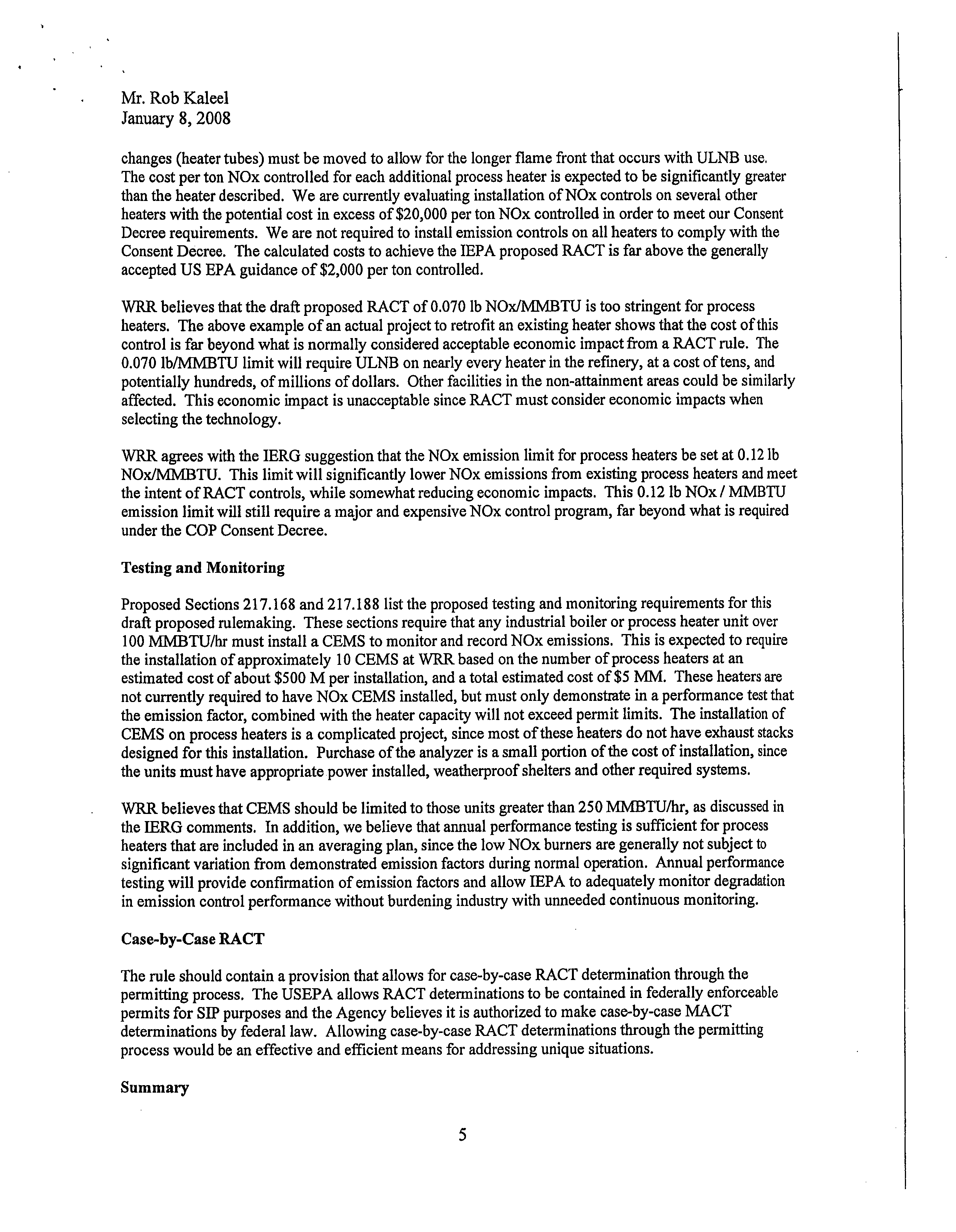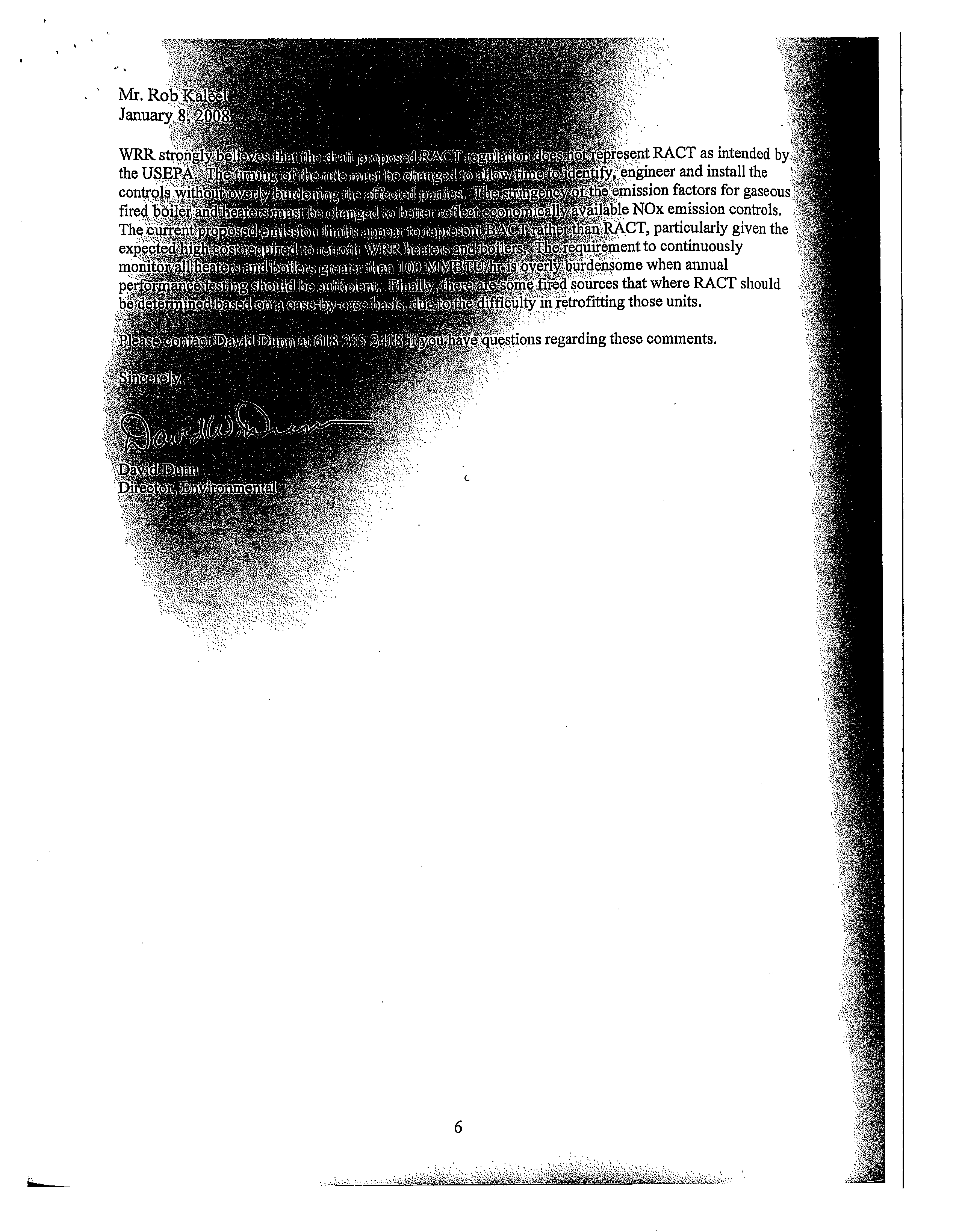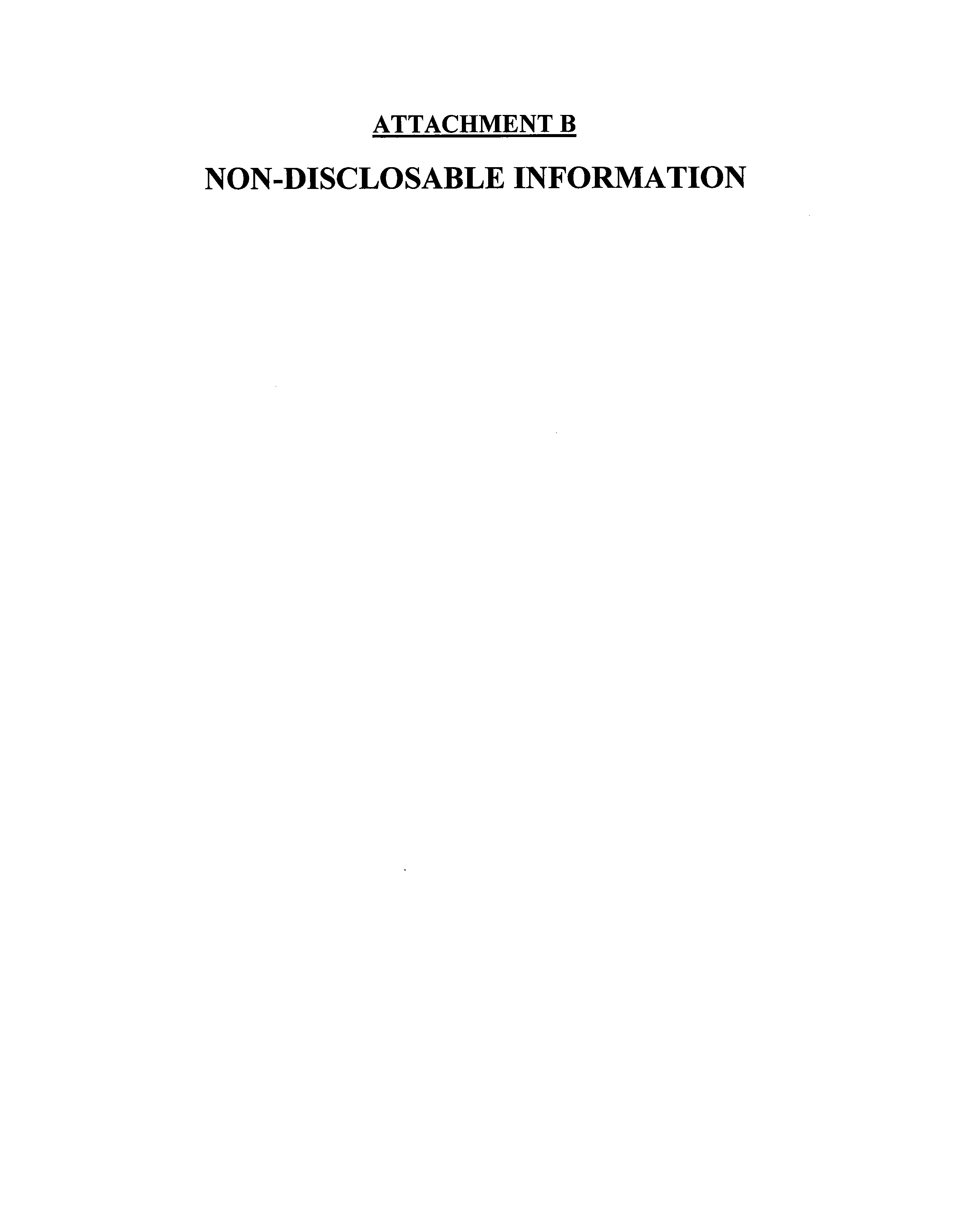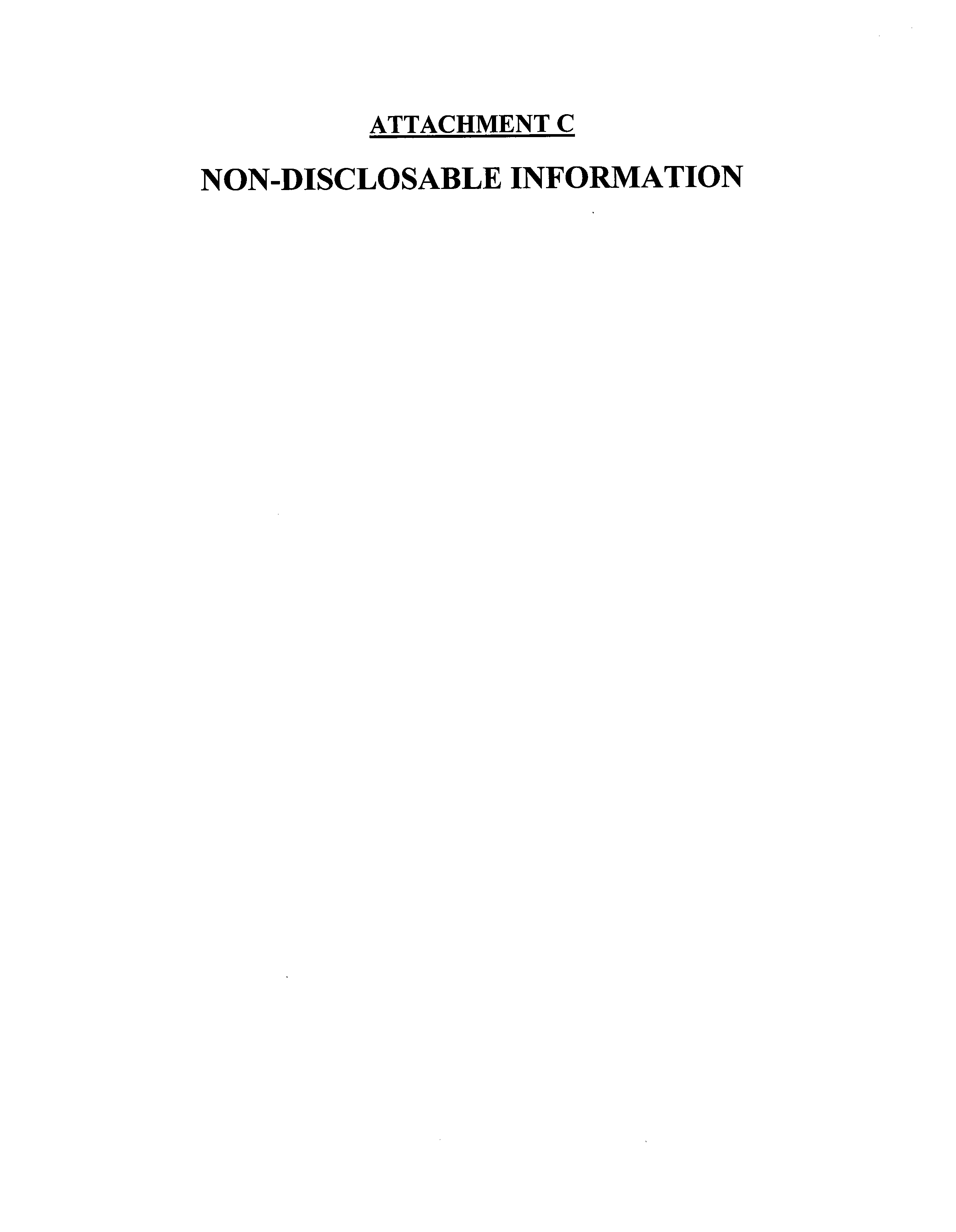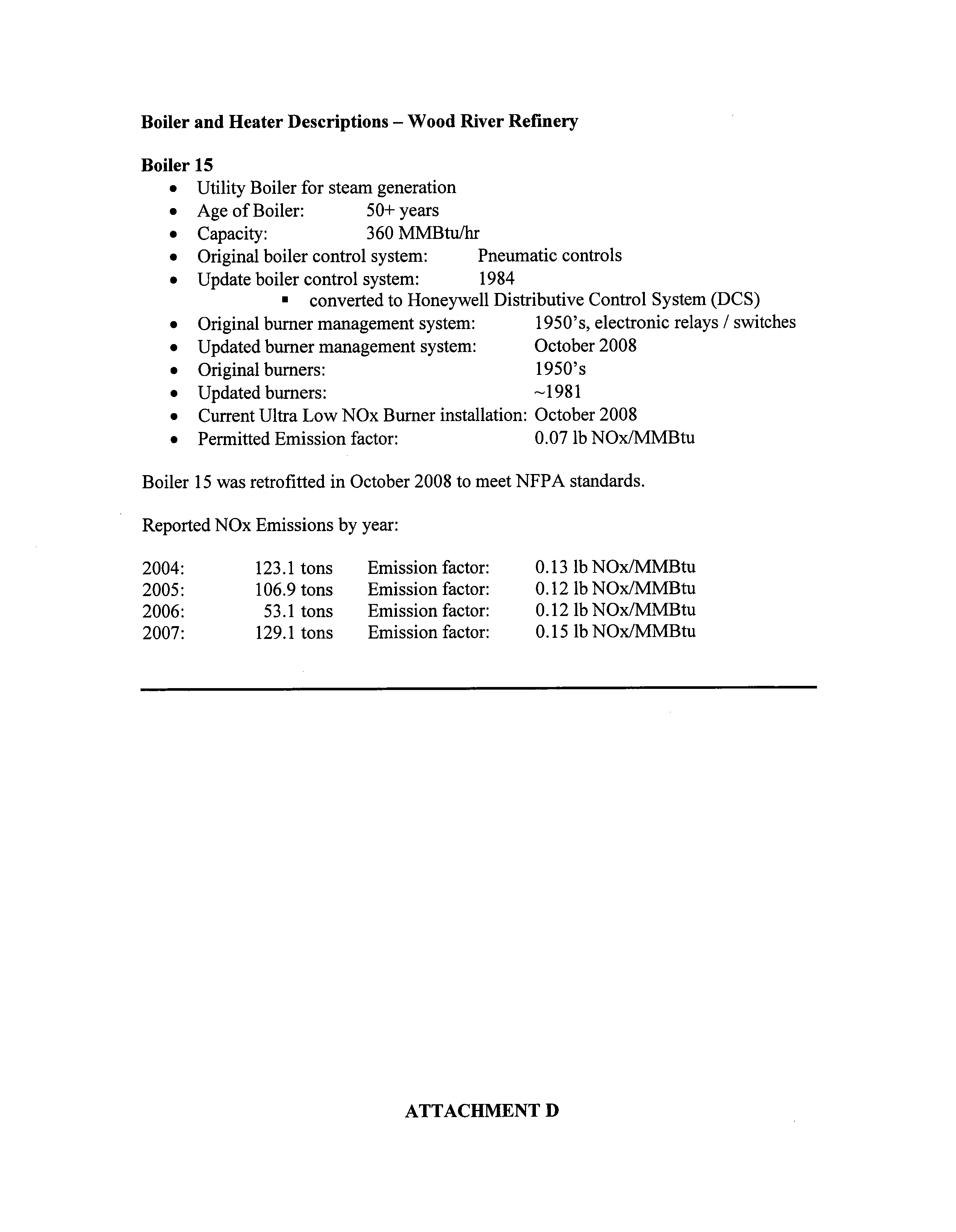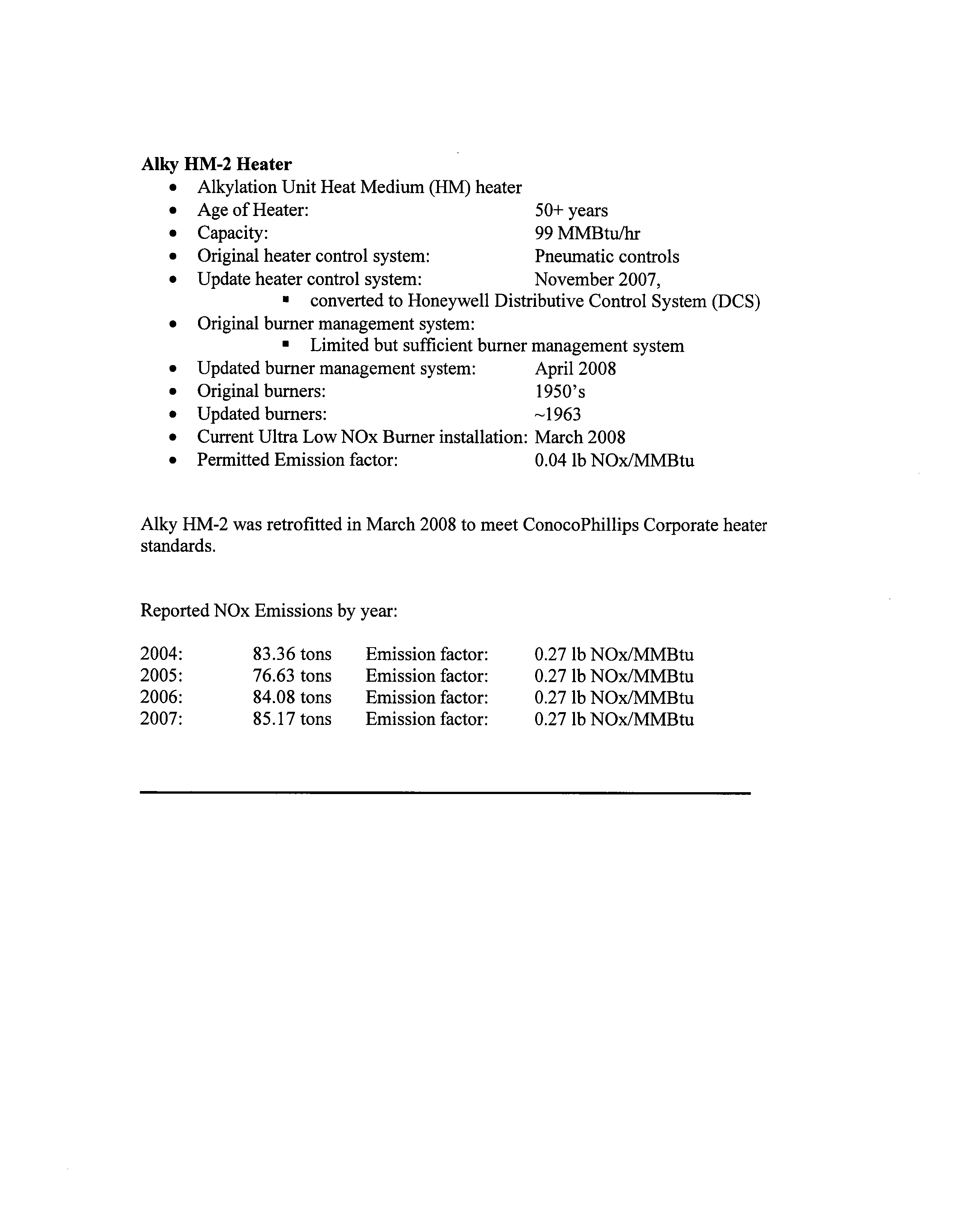ýR
flODGI
ý
DWAR
Y ZRAN
A T T O R N
E
Y
S A T L A W
K ATHERINE
D. HODGE
E-mail: khodge@hdzlaw.com
January 20, 2009
VIA FEDERAL EXPRESS
Mr. John T. Therriault
Assistant Clerk
of the Board
Illinois Pollution Control Board
100
West Randolph Street, Suite 11-500
Chicago, Illinois
60601
Timothy Fox, Esq.
Hearing Officer
Illinois Pollution Control Board
100 West Randolph
Street, Suite 11-500
Chicago, Illinois
60601
RE: Application for Non-Disclosable
Information
In the Matter of: Nitrogen
Oxides Emission from Various
Source
Categories: Amendments to
3.5 111. Adm. Code Parts 211 and
217, R08-19
Dear Sirs:
In connection with the above-referenced
rulemaking, ConocoPhillips Companv
("ConocoPhillips")
is submitting the attached Supporting
Materials to the Illinois Pollution
Control Board ("Board").
Attachments B and C of the Supporting
Materials are being submitted
as NON-DISCLOSABLE INFORMATION
to the Board pursuant
to 35 Ill. Adm. Code Part 130.
"Non-disclosable information" is defined in part
as "information concerning
secret
manufacturing
processes or confidential data submitted
by any person under the [Illinois
Environmental
Protection] Act." 35 Ill. Admin.
Code § 101.202 (citing 415 ILCS 5/7((a)).
Attachments B
and C are documents containing confidential data
and information regarding cost
evaluations of projects at ConocoPhillips'
facility, as well as a turnaround
schedule for
maintaining and/or upgrading process
heaters at the facility.
To facilitate
the Board's protection of Attachments
B and C as non-disclosable
information, we are
providing the information required by
Section 130.404 of the Board's rules.
The information in Attachments
B and C is business confidential
data and is not available
publicly outside ConocoPhillips and is restricted
information within ConocoPhillips.
3 150 ROLAND AVENUE A
POST OFFICE BOX 5776 A
SPRINGFIELD, ILLINOIS 62705-5776
TELEPHONE
217-523-4900 A FACSIMILE
217-523-4948
Electronic Filing - Received, Clerk's Office, January 20, 2009
* * * * * PC # 5 * * * * *
Mr. John T. Therriault
Timothy Fox, Esq.
January 20, 2009
Page
2
Accordingly,
access to the information included
in Attachment B is limited to
only management
level employees and
project engineers that are required
to use the information during
the course
of their job duties. Similarly,
access to information included
in Attachment
C is
limited
to only
management level employees
and other employees that are
required to use the information
during the course of their job duties
for business planning purposes.
Information provided in
Attachment
B has competitive value
based on negotiated price of
the equipment that will be
installed, and
the information in Attachment
C is vital to strategically planning
future operations
in accordance with
the company's business plan. Thus,
confidential information in
Attachments
B
and C is considered sensitive
in a competitive market
and disclosure of such information
would
provide an advantage to
competitors in terms of negotiation
of project costs and
knowledge
of when the facility will not
be operating all of its units. ConocoPhillips
treats the
information in Attachments
B and C as business
confidential and proprietary
and has no
knowledge that the information
has been published or
disseminated beyond the company,
except
to
outside counsel who are
obligated to treat the information
as protected.
As required
by the Board's rules, Attachments
B and C have been labeled
as NON-
DISCLOSABLE
INFORMATION. In addition, in
accordance with Section
130.404(e)(4), we
have enclosed the affidavit
of Mr. David Dunn verifying
the facts set forth above. This letter
constitutes
an unlimited waiver
of any statutory determination
process.
If you have any questions regarding
the above, please do not hesitate
to contact me.
KDH:MTR:db
enclosures
C NPH:OI I/Fil/R08-19/Application
for Non-Discl. Info.
Electronic Filing - Received, Clerk's Office, January 20, 2009
* * * * * PC # 5 * * * * *
STATE OF ILLINOIS
)
SS
COUNTY OF MADISON )
AFFIDAVIT OF DAVID W. DUNN
I, David W. Dunn, on behalf of
CONOCOPHILLIPS
COMPANY
("ConocoPhillips"),
being first
duly sworn, depose and state as follows:
1.
I am the Environmental Director of ConocoPhillips' Wood River Refinery.
2 .
I have reviewed the application for non-disclosable information dated January 20,
2008 and the Supporting Materials to be filed with the Illinois Pollution
Control Board in the
R08-19 rulemaking.
3 .
The
information contained in Attachments B and C of the Supporting Materials is
not available publicly outside ConocoPhillips and is restricted information
within
ConocoPhillips.
a.
Access to the information included in Attachment B is limited
to only
management level employees and project engineers that are required to
use the information during the course of their job duties.
b.
Access to the information included in Attachment C is limited to only
management level employees and other employees that are required to use
the information during the course of their job duties or for
business
planning purposes.
4.
The information provided in Attachment B has competitive
value based on the
negotiated price of the equipment that will be installed at the facility. The information in
Attachment C is vital to planning future operations in accordance with the company's
business
plan.
Electronic Filing - Received, Clerk's Office, January 20, 2009
* * * * * PC # 5 * * * * *
5.
The
information in Attachments B and C is considered sensitive
in
a
competitive
market and disclosure of such information could provide an advantage to
competitors in terms of
negotiation of project costs and knowledge of when
the facility will not be operating all of its
units.
6.
ConocoPhillips
treats the information in Attachments B and C
as business
confidential
and proprietary. I have no knowledge that the information
has been published or
disseminated beyond the company, except to outside counsel.
Under penalties as provided by law
pursuant to Section 1-109 of the Code of
Civil Procedure, the undersigned
certifies that the statements set forth in this
instrument
are true and correct, except as to matters therein stated to
be on
information
and belief and as to such matters the undersigned
certifies as
aforesaid that
he
verily
believes the same to be true.
Further Afflant Sayeth Not.
David W. Dunn
S ubscribed and sworn to before me
this 40 day of u,c
2009.
OFFICIAL SEAL
CAROL HALLOWS
NOTARY PUBLIC
- STATE OF ILLINOIS
MY COMMISSION
EXPIRES:04127112
Notary
Public
CNPH:O11/HVR08-19/Affidavit
of D. Dunn
Electronic Filing - Received, Clerk's Office, January 20, 2009
* * * * * PC # 5 * * * * *
BEFORE THE ILLINOIS POLLUTION
CONTROL BOARD
IN THE MATTER
OF:
)
NITROGEN OXIDES EMISSIONS
FROM )
VARIOUS SOURCE CATEGORIES: )
AMENDMENTS TO 35 ILL. ADM. CODE )
PARTS 211 and 217
)
R08-19
(Rulemaking - Air)
NOTICE OF FILING
TO: Mr.
John T. Therriault
Assistant
Clerk of the Board
Illinois Pollution Control Board
100 W. Randolph Street
S uite 11-500
Chicago, Illinois
60601
(VIA ELECTRONIC
MAIL)
Timothy Fox,
Esq.
Hearing Officer
Illinois Pollution Control Board
100
W. Randolph Street
Suite 11-500
Chicago, Illinois 60601
(VIA FIRST CLASS MAIL)
(SEE PERSONS ON ATTACHED SERVICE LIST)
P LEASE TAKE NOTICE
that I have today filed with the Office of the Clerk of
the Illinois Pollution Control Board
the SUPPORTING MATERIALS FROM
CONOCOPHILLIPS COMPANY, a copy of which is herewith
served upon you.
Respectfully submitted,
By:
/s/ Katherine D. Hodge
Katherine D. Hodge
Dated: January 20, 2009
Katherine D. Hodge
Monica T. Rios
HODGE DWYER
ZEMAN
3150 Roland Avenue
Post Office Box 5776
Springfield, Illinois 62705-5776
(217) 523-4900
THIS FILING
SUBMITTED ON RECYCLED PAPER
Electronic Filing - Received, Clerk's Office, January 20, 2009
* * * * * PC # 5 * * * * *
CERTIFICATE OF SERVICE
I, Katherine
D. Hodge, the undersigned, hereby certify
that I have served the
attached SUPPORTING MATERIALS
FROM CONOCOPHILLIPS COMPANY
upon:
Mr. John T. Therriault
Assistant
Clerk of the Board
Illinois Pollution
Control Board
100 West Randolph Street, Suite 11-500
Chicago, Illinois 60601
via electronic
mail on January 20, 2009; and upon:
Timothy Fox, Esq.
Hearing Officer
Illinois Pollution Control Board
100
West Randolph, Suite 11-500
Chicago, Illinois
60601
Gina Roccaforte, Esq.
John J. Kim, Esq.
Division of Legal
Counsel
Illinois Environmental Protection
Agency
1021 North Grand Avenue East
P ost Office Box 19276
Springfield, Illinois 62794-9276
Virginia Yang,
Esq.
Deputy Legal Counsel
Illinois Department of Natural Resources
One Natural Resources Way
Springfield, Illinois
62702-1271
by depositing said document in the
United
Springfield, Illinois
on January 20, 2009.
Matthew J. Dunn,
Esq.
Chief, Environmental Bureau North
Office of the Attorney General
69 West
Washington Street, Suite 1800
Chicago, Illinois 60602
Kathleen
C. Bassi, Esq.
Stephen
J. Bonebrake, Esq.
Schiff Hardin, LLP
6600 Sears Tower
233 South Wacker Drive
Chicago,
Illinois 60606-6473
Christina L. Archer, Esq.
Associate General Counsel
Arcelormittal USA, Inc.
1
South Dearborn, 19th Floor
Chicago, Illinois 60603
States Mail, postage prepaid, in
/s/ Katherine D. Hodge
Katherine
D. Hodge
CNPH:011/Fil/R08-19/NOF-COS - Supporting Materials
Electronic Filing - Received, Clerk's Office, January 20, 2009
* * * * * PC # 5 * * * * *
BEFORE THE
ILLINOIS POLLUTION
CONTROL BOARD
IN THE MATTER OF:
)
R08-19
NITROGEN
OXIDES EMISSIONS FROM ) (Rulemaking
- Air)
VARIOUS SOURCE
CATEGORIES: )
AMENDMENTS TO 35 ILL.
ADM. CODE )
PARTS
211 and 217
)
S UPPORTING MATERIALS
FROM CONOCOPHILLIPS
COMPANY
N OW COMES CONOCOPHILLIPS
COMPANY ("ConocoPhillips"),
by and through
its
attorneys,
HODGE DWYER ZEMAN, and submits
the attached SUPPORTING
MATERIALS
in the above-referenced
matter.
1 . On December 9, 2008,
Mr. David W. Dunn on
behalf of ConocoPhillips
presented
testimony in the
above-referenced matter. During
the course of his testimony,
the Illinois
Environmental Protection Agency ("Agency")
or the Illinois
Pollution Control Board
("Board")
requested additional
documents or information in
response to testimony that
Mr. Dunn provided.
2.
As stated at hearing
and in the cover letter to
this filing, two of the enclosed
Attachments are
being submitted to the Board
as NON-DISCLOSABLE INFORMATION
pursuant to 35111. Admin.
Code Part 130.
3.
The following materials
are being provided in response
to Agency or Board
requests at hearing:
a.
On pages
151 and 154 of the December
9, 2008 transcript, the
Agency requested
cost analysis information for
the boiler and
process heater examples referenced
in Mr. Dunn's pre-filed
testimony.
As Mr. Dunn stated
at hearing, such information
was
provided
to the Agency in January 2008
as confidential business
information. ConocoPhillips
has provided, as Attachment
A, a
Electronic Filing - Received, Clerk's Office, January 20, 2009
* * * * * PC # 5 * * * * *
January 8, 2008 letter
to the
Agency
regarding comments on the
R08-19 rulemaking proposal. In addition,
ConocoPhillips has
provided, pursuant to 35111. Admin. Code Part 130, its
cost
analysis data as NON-DISCLOSABLE INFORMATION, which is
attached hereto as Attachment B.
b.
On
pages
156 through 157 of the December 9, 2008 transcript, the
Board requested that the turnaround schedule for process heaters
be provided, if possible. As noted at hearing, the turnaround
schedule is confidential for business purposes. Accordingly,
ConocoPhillips
is
submitting a turnaround schedule for affected
heaters at its facility as NON-DISCLOSABLE
INFORMATION
pursuant to 35 Ill Admin. Code Part
13 0.
The confidential
turnaround schedule is attached hereto as Attachment C.
c.
On
page 153
of the
December
9,
2008 transcript,
the Agency
inquired as to the age of the burners and burner management
system for the boiler referenced on page 7 of Mr. Dunn's
testimony. Information regarding the age of the burners and
burner management system for Boiler 15, as well as information
regarding the actual emissions rate and factor for the
examples
discussed in Mr. Dunn's testimony, is attached hereto as
Attachment D.
4.
As provided in the cover letter to this filing, ConocoPhillips has submitted
Attachments B and C as NON-DISCLOSABLE INFORMATION pursuant to 35 Ill. Admin.
Code Part 130 and requests that such Attachments be handled by the Board in accordance with
35 111. Admin. Code Part 130.
Electronic Filing - Received, Clerk's Office, January 20, 2009
* * * * * PC # 5 * * * * *
5.
ConocoPhillips reserves
the right to supplement these supporting materials.
Respectfully submitted,
By: /s/ Katherine
D. Hodge
Katherine D. Hodge
D ated: January 20, 2009
K atherine D. Hodge
Monica T. Rios
HODGE DWYER ZEMAN
3150 Roland Avenue
Post
Office Box 5776
Springfield, Illinois
62705-5776
(217) 523-4900
C NPH:011/Fil/R09-19/Supporting Materials
Electronic Filing - Received, Clerk's Office, January 20, 2009
* * * * * PC # 5 * * * * *
aaoý
ooýG L
o
ýo9
ConocoPhilli s
January 8, 2008
CERTIFIED MAIL
RETURN RECEIPT REOUESTED
Mr. Rob Kaleel
Manager, Air Quality Planning Section
Illinois
Environmental Protection Agency
1021
North Grand Avenue East
P.O. Box 1276
Springfield, IL 62794-9276
Re: Draft Regulatory Proposal
NOx rule posted on July 30,2007; revised December 19, 2007
Dear
Mr.
Kaleel:
W ood River Refinery
P. O. Box 76
900 South Central
Avenue
Roxana, Illinois 62084
Enclosed for your consideration are comments
prepared by ConocoPhillips on behalf of the WRB
Refining LLC refinery in Roxana, Illinois regarding the Illinois EPA's draft NOx rulemaking (December
19, 2007 version).
The
Wood River Refinery (WRR) has operated in Illinois since 1917. It refines more than 300,000
barrels
of
crude
oil per day and currently employs more than 600 employees and a large number of
contractors.
WRR
is located
in Madison County, which is included in the St. Louis ozone moderate
nonattainment area.
WRB Refining LLC is a joint venture between ConocoPhillips and Encana that was created on January 1,
2007. ConocoPhillips is the operator of the WRR facility for the joint venture. ConocoPhillips is a
member
of the Illinois Environmental Regulatory Group.
The comments described below reflect a careful
consideration of the draft regulatory proposal and a
comparison against ongoing projects
to reduce NOx in the refinery. The regulatory proposal as drafted
could
significantly
affect
WRR operations by requiring overly stringent and unreasonable NOx controls
to be installed on many
boiler and heaters. The compliance date included in the draft is not achievable,
based
on
the remaining
time to design, plan, purchase, install the controls, and complete performance
testing on a large number of emission sources. Installation
of the controls included in the proposed draft
will require entire processing units to be shut down for several weeks.
Very
few of the affected units
are
currently scheduled for maintenance turnarounds before the compliance deadline and, therefore, any
unscheduled refinery unit shutdowns will have a significant effect on the fuel supply in the Midwest
market.
WRR supports the comments that
IERG
filed
on October 15, 2007 and subsequent IERG
comments
and
offers the following
specific
comments
on the impacts this regulatory proposal could
have
on WRR.
ATTACENENT A
Electronic Filing - Received, Clerk's Office, January 20, 2009
* * * * * PC # 5 * * * * *
Mr. Rob Kaleel
January 8, 2008
For background purposes, WRR notes that the refinery is subject to a 2005 Clean Air Act enforcement
consent decree (the Consent Decree) between ConocoPhillips, WRB, the United States and the State of
Illinois.
This Decree includes significant requirements to reduce NOx emissions from existing heaters
and
boilers throughout COPC's U.S refineries, including those in Illinois. Many of the comments
provided
herein are based on the experience we have gained in
implementing
those
Consent Decree
provisions.
Compliance
date deadline
Proposed Section 217.152 includes a compliance date of May 1, 2010 for the installation of controls and
demonstration of compliance for all affected facilities. This date is not achievable given the design,
engineering,
purchasing, and construction challenges that would
be required to meet the very stringent
emission limits noted in the draft proposal. There are several reasons why this date is not achievable,
a. As of the filing of these comments, only 28 months remain before compliance must be certified.
The regulation has not been finalized and the parties subject to the regulation are not certain with
what they must comply. WRR has not prepared a detailed compliance plan at this time, since it
is
unclear what we must include in the plan,
b. Every heater and boiler that is included in the as-yet-to-be-determined plan
must be carefully
evaluated to determine the most efficient compliance plan.
This evaluation must include
assessments of existing controls, potential future
controls, potential future process changes and
economic considerations before the plan can be
finalized. The averaging plan included in the
draft proposal
must be evaluated to determine if certain equipment can be over-controlled to
balance out under-controlled equipment. Development of the initial compliance plan
is
expected
to take WRR at least 6 months, and will probably remain open to modification
several months
after that while more detailed engineering studies are completed
on the affected boilers and
heaters.
c. An engineering study
must be completed on each heater that must be controlled after the
compliance
plan is developed. WRR
is in the process of installing NOx controls on several
heaters
at
this time as part of the above-described COP Consent Decree. The engineering phase
of these projects has been up to 10 months long, depending on whether the
heater fire box
must
be modified and how the original equipment must be changed. In
many cases, these heaters have
been chosen as the easiest and most cost-effective
sources from which to obtain NOx emissions
reductions at the refinery. Additional
heaters are likely to require even more engineering
resources and time to meet RACT emissions requirements since the retrofits are likely to be more
complicated and more difficult to complete.
d. Air construction permits may be needed on some units to ensure
that the controls and other
operational changes are federally enforceable. Permit applications
typically take 2 to 3 months to
prepare followed by another 3 months for IEPA review and approval.
e. After the design is completed, equipment must be ordered
and shutdown planning completed.
Ultra Low NOx burners, which are the apparent RACT
control technology proposed in the draft
proposal, are taking at least 6 months for delivery for
our existing projects. Shutdown planning
and preparation can occur during this time, but
very little other work can move forward.
f. In all, WRR may
need to install emission controls, or make other changes, on 19 boilers and
heaters, across
13 operating units. Typically, WRR completes maintenance turnarounds on a 5
year cycle with all units scheduled sometime during the cycle.
A
few
of the affected heaters
and
one of the boilers are scheduled for a maintenance turnaround
during 2008 and 2009. The
remaining units are not scheduled before the
2010
deadline
but instead are planned through 2011.
Early turnarounds to upgrade other heaters will
impact the Midwest fuel supply, including the
entire state of Illinois, potentially causing significantly
higher gasoline and diesel fuel costs for a
period of time.
Electronic Filing - Received, Clerk's Office, January 20, 2009
* * * * * PC # 5 * * * * *
Mr. Rob Kaleel
January 8, 2008
g. In addition, it is unlikely that sufficient contractor maintenance staff will be available to complete
all of the heater and boiler upgrades that are required. Performance testing contractors may also
not be available to certify the new controls as required in the draft proposal.
Based on these reasons, WRR suggests that the compliance deadline be extended until at least December
31, 2013. We further suggest, to show ongoing improvement during
the
intervening
period,
that
a
schedule for implementation of NOx controls could be submitted by affected parties by
January 1, 2009,
with a requirement for 25% of proposed NOx controls
in place by May 1, 2010.
This
extended schedule
would help satisfy the "reasonably available" definition for RACT.
Subpart D: Industrial Boilers
Proposed
Section 217.160 describes what
industrial
boilers
are included in the
draft
proposal and includes
an emission limit for these boilers. WRR industrial boilers burn
only gaseous fuels and our comments
will be limited to this subset. The gaseous fuel
that is
burned
on the
WRR
site includes natural gas and
refinery
gas. Refinery
gas is similar to natural gas, but includes other hydrocarbon compounds that
increase
NOx
emissions to
some
degree. Refinery gas is a co-product of the refining process and is
typically consumed by onsite heaters and boilers to improve overall refining energy efficiency and reduce
flaring.
The draft proposal includes emission limits
for boilers greater than 100 MMBTU/hr of 0.080 lb/MIVIBTU.
This proposed RACT emission limit is overly stringent for typical industrial boilers when burning
refinery fuel gas. This emission limit will require the equivalent of Ultra Low NOx
control
technology
that is well beyond RACT.
WRR is presently designing NOx controls for an existing
onsite boiler as part of its Consent Decree
requirements to reduce overall NOx emissions. This boiler
is larger than 100 MMBTU/hr and does not
have NOx emission reducing burners at this
time. The Consent Decree requires that Ultra Low NOx
burners
(ULNB)
be installed to
qualify
for NOx reduction credit. The burner vendor will guarantee
that
the boiler will perform better than 0.070 lbs NOx / MMBTU with the ULNB.
It
has
taken more than 10
months to design the retrofit for this boiler. The permit application is in preparation
and should be
submitted in 2 months. We expect it will take approximately
3 months before IEPA will issue the permit.
A three week long shutdown
is
scheduled
for the boiler during the third quarter of 2008 to modify the
boiler. Total
time for
this project to be completed will be at least 20 months. Fortunately, this emission
control
system will
be in place before May 1, 2010. The estimated cost of the control system per ton of
NOx controlled is in excess of $20,000 per ton NOx controlled, without considering the installation
of a
NOx CEMS. A summary of the cost evaluation will be provided under separate, business confidential,
cover.
The above boiler was selected for retrofitting because it
had one of the easiest configurations to make the
required changes when compared to the other boilers
on the WRR site. The cost per ton controlled for
retrofitting the other boilers is expected
to be higher.
WRR believes that the
draft proposal RACT for industrial boilers is too stringent,
based on the cost of
control and the guaranteed emission factor. RACT is defined in 40CFR51.100(o)
as:
o)
«Reasonably available control technology>> (RACT)
means devices, systems, process
modifications, or other apparatus or techniques that
are reasonably available taking into account:
`b]-,(l) The necessity of imposing such controls in order
to attain and maintain a national ambient
air quality standard;
U,(2) The social, environmental, and economic impact of such controls;
and
3
Electronic Filing - Received, Clerk's Office, January 20, 2009
* * * * * PC # 5 * * * * *
Mr. Rob Kaleel
January 8, 2008
%7?(3)
Alternative means of providing for attainment and maintenance
of such standard. (This
provision defines RACT for the purposes of §51.341(b) only.)
The term "reasonable" is
defined
in
Webster's New College dictionary as "governed by
or
in
accordance
with reason or sound thinking", "within the
bounds of common sense," and finally "not extreme
or
excessive." WRR believes that these
definitions should be used in determining what a RACT
technology
is. Using these definitions, RACT is technology where equipment
is readily available, can be obtained on
a timely basis, and can be installed for a cost is not excessive.
Common sense should prevail in making
these decisions.
Generally, RACT should not mean "best available", since this
could imply a stretch,
technically and economically, for
the facilities where the rule applies.
Item (2) says that social, environmental AND economic impact
of such controls must be taken into
account. The proposed emission factor of 0.080 for boilers
does not adequately consider the economic
consequences on the companies that are required to install these controls.
In addition, ULNB are
currently "best available control technology" (BACT) for industrial
boilers and are only required for new
or significantly modified units. A comparison of the cost of the NOx control
on this boiler is 8 to 10
times more costly than the typical RACT control cost per ton ($2,000 - 2,500) in
other
moderate
nonattainment areas.
IEPA must reconsider the economic impact that
the proposed low emission factor will have on industry.
We recommend 0.12 lb NOx/MVIBTU that is recommended
by lERG in their comments. We believe that
this emission factor can be reasonably achieved while satisfying
all the parameters that must be
considered.
Subpart E: Process Heaters
Proposed Section 217.184 describes what process heaters are
included in the draft proposal and includes
an emission limit for these heaters. WRR process heaters burn
only refinery gaseous fuels, as described
above, and our comments will be limited to this subset.
As noted above, the gaseous fuel that is
burned on the WRR site includes natural gas and refinery gas.
Refinery gas is similar to natural gas, but includes other components that increase
NOx emissions to some
degree. The draft proposal includes emission limits for boilers greater than 100 MMBTU/hr
of 0.070
lb/1VIIVIBTU. This proposed emission limit is too stringent for typical process heaters and requires Ultra
Low NOx control technology that is well beyond BACT.
WRR is in the process of installing NOx controls in an existing process heater as part of its Consent
Decree
requirements to reduce overall NOx emissions. This heater is slightly smaller than 100
MMBTU/hr, however, it serves as an excellent example
of
the
economic consequence of retrofitting
existing process heaters with ULNB. The process heater does not have
NOx emission reducing burners at
this time. The Consent Decree requires that Ultra Low NOx burners (ULNB) be installed
to qualify for
NOx reduction credit. The burner vendor will guarantee that the boiler will perform at least at 0.050
lbs
NOx / MMBTU with the ULNB. The ULNB changes to this unit were designed over a 6 month period
and are already permitted. A significant modification to the floor of the heater is required to
accommodate the ULNB. The estimated cost of the control system per ton of NOx controlled is in excess
of $15,000 per ton NOx controlled, without considering the installation of a NOx CEMS. A summary of
the cost evaluation will be provided under separate, business confidential, cover.
WRR has 16 process heaters with heat input capacities greater than 100 MMBTU/hr
and, thus, must
evaluate how to control NOx emissions under the RACT rule. The process heater described above
was
selected for early NOx emission reductions primarily because it was one of the easiest to retrofit. The
installation
of NOx emission controls on the remaining process heaters will involve more detailed
engineering to evaluate how the fire boxes
and floors must be modified to include ULNB and what other
4
Electronic Filing - Received, Clerk's Office, January 20, 2009
* * * * * PC # 5 * * * * *
Mr. Rob Kaleel
January 8, 2008
changes (heater tubes) must be moved to allow for the longer flame
front that occurs with
ULNB
use.
The cost per ton NOx controlled for each additional process
heater is expected to be significantly greater
than the heater described. We are currently evaluating
installation of NOx controls on several other
heaters
with the potential cost in
excess
of
$20,000 per
ton
NOx controlled in order to meet our Consent
Decree requirements.
We
are not required to install emission controls on all heaters to comply with the
Consent Decree. The calculated costs to achieve the IEPA proposed RACT is far above the generally
accepted US EPA guidance of $2,000 per ton controlled.
WRR believes that the draft proposed RACT of
0.0701b
NOx/MMBTU
is too stringent for process
heaters. The above example of an actual project
to retrofit an existing heater shows that the cost of this
control is far beyond what is normally considered acceptable
economic impact from a RACT rule. The
0.070
lb/MMBTU limit will require ULNB
on nearly every heater in the refinery, at a cost of tens, and
potentially hundreds, of millions
of
dollars.
Other facilities in the non-attainment areas could be similarly
affected.
This economic impact is
unacceptable since RACT must consider economic impacts when
selecting
the
technology.
WRR agrees with the IERG suggestion that the NOx emission limit for process
heaters
be
set at 0.12 lb
NOx/MMBTU. This limit will significantly lower NOx emissions from
existing process heaters and meet
the intent of RACT controls, while somewhat reducing economic
impacts. This 0.121b NOx / MMBTU
emission limit will still require a major and expensive NOx
control program, far beyond what is required
under the COP Consent Decree.
Testing
and Monitoring
Proposed Sections 217.168 and 217.188 list the proposed testing
and monitoring requirements for this
draft proposed rulemaking. These sections
require that any industrial boiler or process heater unit
over
100
MMBTU/hr must install a CEMS
to monitor and record NOx emissions. This is expected to
require
the installation of approximately 10 CEMS at WRR based on the number
of process heaters at an
estimated cost of about $500 M per installation, and a total estimated
cost of $5 MM. These heaters are
not currently required to have NOx CEMS installed, but must
only demonstrate in a performance test that
the emission factor, combined with the heater capacity will
not exceed permit limits. The installation of
CEMS on process heaters is a complicated project,
since most of these heaters do not have exhaust
stacks
designed for this installation. Purchase of
the
analyzer
is a small portion of the cost of installation,
since
the units must have appropriate power installed,
weatherproof shelters and other required
systems.
WRR
believes
that CEMS should be limited to those units greater than
250 MMBTU/hr, as discussed in
the IERG comments. In addition, we believe that annual performance
testing is sufficient for process
heaters that are included in an averaging plan, since the low
NOx burners are generally not subject to
significant variation from demonstrated emission factors
during normal operation. Annual performance
testing will provide confirmation of emission
factors and allow IEPA to adequately
monitor degradation
in emission control performance without burdening
industry with unneeded continuous
monitoring.
Case-by-Case RACT
The rule
should
contain a provision that allows for case-by-case RACT
determination through the
permitting process. The USEPA allows RACT determinations
to be contained in federally enforceable
permits for SIP purposes and the Agency believes
it is
authorized
to make case-by-case MACT
determinations by federal law. Allowing
case-by-case RACT determinations through the
permitting
process would be an
effective
and
efficient means for addressing unique situations.
Summary
Electronic Filing - Received, Clerk's Office, January 20, 2009
* * * * * PC # 5 * * * * *
WIM IS
ULLCUUCQ
Dy,ýý
t
b
1hie,
B
Uý
TTQ
eer and install the I
CO-4"
.
I
ssion fucturs
for gaseous;'
;
4 a NOx emission controls.
The
c`
CT, particularly given the
`;
exp
uirý;nent
to continuously
d oma
when annual
F -ýý
I I I III
11 1
111 11
IR
1 1
tnose, units.
ý upstlons regarding these
comments.
ý ''hý{s1ý' )2ý1
`I
I
Pý:JyiCiý ICiýEi4tP1
:M
;?C
6
Electronic Filing - Received, Clerk's Office, January 20, 2009
* * * * * PC # 5 * * * * *
ATTACHMENT B
N ON-DISCLOSABLE INFORMATION
Electronic Filing - Received, Clerk's Office, January 20, 2009
* * * * * PC # 5 * * * * *
ATTACHMENT C
N ON-DISCLOSABLE
INFORMATION
Electronic Filing - Received, Clerk's Office, January 20, 2009
* * * * * PC # 5 * * * * *
Boiler and Heater Descriptions - Wood River Refinery
Boiler 15
" Utility Boiler for steam generation
" Age of Boiler:
50+
years
" Capacity:
360 MMBtu/hr
" Original boiler control system:
Pneumatic
controls
" Update boiler control
system:
1984
" converted to Honeywell Distributive Control
System (DCS)
" Original burner management system:
1950's,
electronic relays / switches
" Updated burner management
system:
October 2008
" Original burners:
1950's
" Updated burners:
1981
" Current Ultra Low NOx Burner
installation: October 2008
" Permitted Emission
factor:
0.07 lb NOx/MMBtu
Boiler 15 was retrofitted in October 2008 to meet NFPA standards.
Reported NOx Emissions by year:
2004:
123.1 tons Emission factor:
0.13 lb
NOx/MMBtu
2005:
106.9 tons Emission
factor:
0.12 lb NOx/MMBtu
2006:
53.1 tons
Emission factor:
0.121b NOx/MMBtu
2007:
129.1 tons
Emission factor:
0.15 lb NOx/MMBtu
ATTACHMENT D
Electronic Filing - Received, Clerk's Office, January 20, 2009
* * * * * PC # 5 * * * * *
Alky HM-2 Heater
" Alkylation Unit Heat Medium (HM) heater
" Age of Heater:
50+
years
" Capacity:
99 MMBtu/hr
" Original heater control system:
Pneumatic controls
" Update heater control system:
November 2007,
" converted to Honeywell Distributive
Control System (DCS)
" Original burner management system:
" Limited but sufficient burner management system
" Updated burner management
system:
April 2008
" Original burners:
1950's
" Updated burners:
1963
" Current Ultra Low NOx Burner installation: March 2008
" Permitted Emission factor:
0.041b NOx/MMBtu
Alky HM-2 was retrofitted in March 2008 to meet ConocoPhillips
Corporate heater
standards.
Reported NOx Emissions by year:
2004:
83.36 tons Emission factor:
0.271b NOx/MMBtu
2005:
76.63 tons Emission factor:
0.271b NOx/MMBtu
2006:
84.08 tons Emission factor:
0.271b NOx/MMBtu
2007:
85.17 tons Emission factor:
0.271b NOx/MMBtu
Electronic Filing - Received, Clerk's Office, January 20, 2009
* * * * * PC # 5 * * * * *
